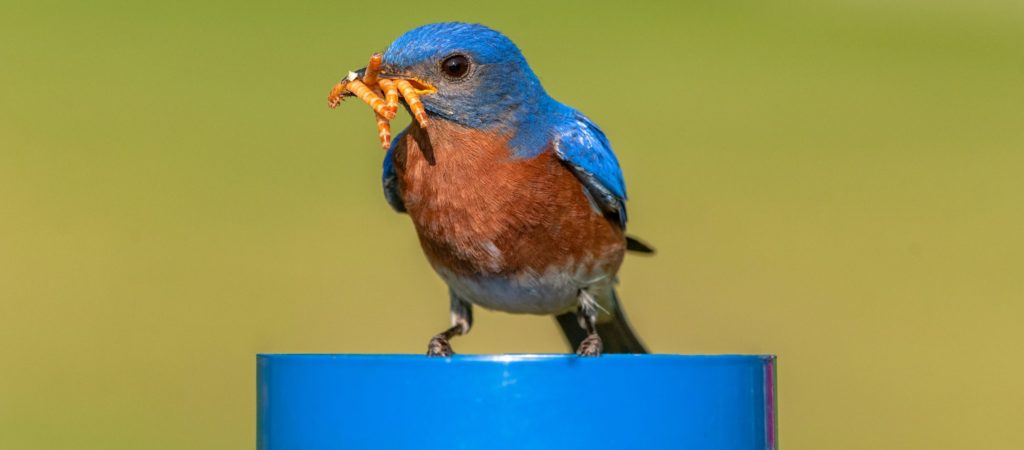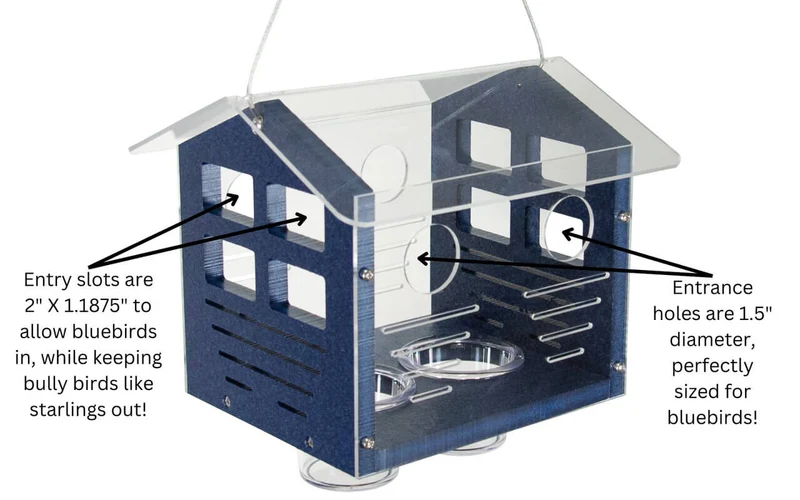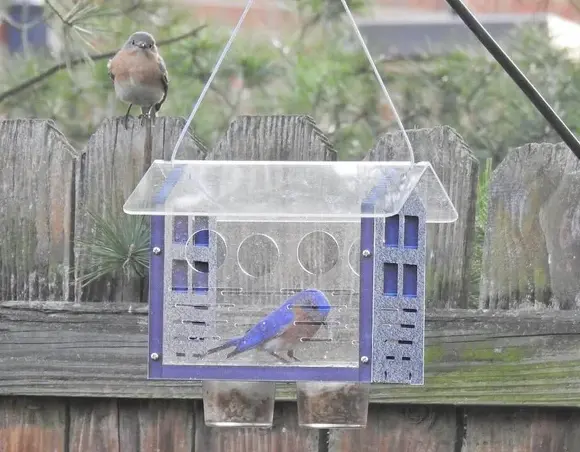How To Feed MEALWORMS To Backyard Birds!
If you are looking for a new food to offer your birds, mealworms are a great choice! They are not only nutritious, but they also attract birds that don’t eat the typical feeder foods, such as sunflower seeds and peanuts.

Unfortunately, not many people use mealworms. Overall, I think there is a general lack of education about them. Some people hear the word “worm” and immediately decide that it’s probably gross (which is not true) and don’t give mealworms a chance.
Today, I’m providing everything you need to know about mealworms!
Check out the table of contents below. Feel free to jump straight to the section that interests you most.
-
TWO reasons why you should be using mealworms (Includes nutritional info)
-
Dried vs. Living Mealworms (And where to purchase them)
-
2 Bird Feeders You Can Use To Offer Mealworms
-
5 Tips For Having SUCCESS Feeding Mealworms
-
What Birds Eat Mealworms? (There are at least 9!)
What exactly are mealworms?

Interestingly, mealworms aren’t actually worms! Instead, they are the larvae of the darkling beetle. If you left a mealworm to continue maturing, eventually, it would look like this:

Mealworms are incredibly easy to raise, which is why they are commercially available. They are used to feed everything from wild birds to chickens to reptiles to fish!
TWO reasons why you should be using mealworms:
#1. Mealworms are healthy!
Because of their high fat and protein content, offering mealworms at your feeding station is very nutritious for wild birds to eat.
Consuming mealworms during winter can be especially helpful since insects and invertebrates are incredibly hard to locate! The additional fat and protein provide needed energy during those cold, snowy nights.
#2. Mealworms attract unique and new birds!
There are many bird species that never visit bird feeders because they don’t eat typical feeder foods like sunflower seeds, safflower seeds, peanuts, etc.

Bluebirds are a great example. These beautiful birds naturally feed mostly on insects, snails, worms, and other invertebrates during the warmer months. Then, they switch their diet to berries in the winter until the bugs come back.
So I’m sure you can see the problem: Bluebirds don’t eat the typical birdseed buffet offered in most bird feeders because the foods don’t align with what they naturally eat.
But it’s possible to attract bluebirds to your bird feeding station with mealworms. And the best part is you don’t have to go digging around your garden for worms and bugs. 🙂
Dried vs. Living Mealworms (and where to buy them)
Mealworms can be purchased in two different ways:
Dried:
Buying dried mealworms is cheaper and less hassle than keeping live mealworms. Dried mealworms also last a LONG time and can be stored easily with the rest of your bird food.
This small bag (18oz / 510g ) is great to purchase to test dried mealworms in your feeders.
*Nutrition Info: 32% fat, 49% protein, 6.9% carbs
Live:
LIVE mealworms for sale on Amazon HERE!
Using living mealworms is not as gross as it may sound. They are not slimy or kept in the dirt. When you purchase mealworms that are alive, they typically come in a small, plastic container filled with dry bedding, such as wheat middling.
Most people keep their live mealworms in the refrigerator. In the cold, they go dormant and can survive for a few months!
*Nutrition Info: 22% fat, 18% protein, 2.5% carbohydrates
And here’s the best part about LIVE mealworms:
Birds prefer them over dried! You can’t really blame the birds for wanting a fresh, juicy mealworm instead of something that is freeze-dried.
This is unfortunate because dried mealworms are much easier to buy and store. Keeping live mealworms is more work since you must provide care to them. Some people also don’t like handling them and get a bit squeamish.
TWO Bird Feeders You Can Use For Mealworms
Not every bird feeder can handle mealworms, especially if you are using live mealworms.
Here are a few options to get you started.
#1. JCS Wildlife Enclosed Mealworm Feeder

View Today's Price – Save 10% automatically by clicking this link
Positives:
- This feeder is designed with bluebirds in mind! The only way to enter is through one of the twelve entry holes. Bluebirds can fit, but bigger birds that also enjoy mealworms, like starlings, can’t!

- Each sidewall is made of transparent and durable acrylic . This allows the bluebirds to find the mealworms AND lets us observe them while inside the feeder.
- The feeder is very well made. The durable eco-friendly recycled poly lumber provides solid construction.
- The roof of this feeder easily slides upward to refill the included mealworm cups and the attached hanging cable means easy mounting.
#2. Erva Mealworm Feeder

The first thing you should notice about this feeder is the metal cage. As you can see, this cage prevents larger birds from gaining access to your mealworms. This is especially important if you buy live mealworms, which are more costly than freeze-dried.
Look closely at the above feeder, and you will see a dish in the middle, which is where you will place the mealworms. But, you can also put other foods in there too. For example, grape jelly or fruit is a great option to attract orioles.
No matter what food you end up using, you can rest easy knowing that only smaller songbirds can get inside to eat!
5 Tips For Successfully Feeding Mealworms
Tip #1. Train your bluebirds to eat dried mealworms.
When many people start using dried mealworms, sometimes they initially have problems with birds eating the new food. This makes sense from a bird’s perspective, as they are used to their insects flying or crawling around, not sitting there already dead!

Watch the two LIVE bird feeder cameras in my backyard HERE!
If you are having this problem, try training your birds with this technique:
- First, start by using LIVE mealworms. Eating a live mealworm is much more natural for birds.
- Once your birds are consistently and eagerly eating these delicious treats, add in just a few dried mealworms. We are hoping they accidentally eat one of the dried options and realize it’s not so bad. Every day increase the number of dried mealworms and decrease the live ones.
- Eventually, you will have trained the bluebirds only to eat dried mealworms! 🙂
Tip #2. Buy mealworms in bulk!
Whether you choose to use dried mealworms or ones that are alive, it will save you money if you buy in large quantities.
For example, check out how much this 10 pound ( (4.5 kg) bag of DRIED mealworms costs on Amazon:
Or did you know that you can buy 5,000 LIVE mealworms at one time? Well, now you do!
Tip #3. Add calcium to mealworms
While mealworms are healthy, they don’t offer complete nutrition and can cause problems if this is the only food that your birds are eating. Specifically, mealworms don’t provide enough calcium, which can cause bone issues in young birds.
And calcium is a vital nutrient for nesting birds. First, it takes a considerable amount of calcium to produce eggshells. And nesting mothers also have to have enough calcium to pass on to their young so that their bones grow strong.
Luckily, you can easily provide extra calcium to mealworms!
Try making a calcium supplement out of chicken eggshells.

- Gather your eggshells
- Boil the eggshells for 5 minutes to sterilize them
- Bake the eggshells at 250 degrees F (120 degrees c) for 10 minutes to dry them out
- Crush the eggshells
- Mix the eggshell powder into mealworms
And if you don’t like that method, you can also buy calcium carbonate powder and sprinkle some on the mealworms before feeding. It’s very inexpensive!
Lastly, I wouldn’t worry about adding calcium to your mealworms if you are not offering a lot of mealworms to your birds. I would only be concerned if you feed mealworms in bulk and the birds never stop eating them!
Tip #4. Offer mealworms at the same time each day.
If you are consistent with when you put the mealworms in your feeders each day, the birds will start to learn when to show up.
Yes, it is possible to train your birds!
Just be consistent. Feed them at the same time and place every day. Soon they will be eagerly waiting for your arrival.
Tip #5. Watch out for starlings!

I am not a fan of European Starlings. You may disagree, but I try to keep these invasive birds away from my feeders.
And unfortunately, European Starlings LOVE mealworms.
If you live in an urban or suburban area, you will probably have to deal with these blackbirds coming for your mealworms. Sadly, I have many starlings in my area, and they are a constant annoyance at my feeders. For example, I don’t see many bluebirds at my house, who love mealworms, because starlings are dominant over them and keep them away.
To help, you can try putting mealworms in a “starling-proof” bird feeder!
Birds You Can Attract With Mealworms

Theoretically, almost any bird that eats insects will sample and eat a mealworm. Live mealworms are especially popular and will attract the widest variety of species!
Here are the most likely birds you will see eating mealworms in your yard. If you want to see the specific species of each bird family that lives near you, click on the link to see a list (includes range maps).
-
Bluebirds
-
Chickadees
-
Nuthatches
-
European Starlings
- Orioles
-
Wrens
-
Titmice
-
Warblers
-
Woodpeckers
-
Catbirds
How do you feed mealworms to birds in your yard?
Let us know what is working best below in the COMMENTS section.





